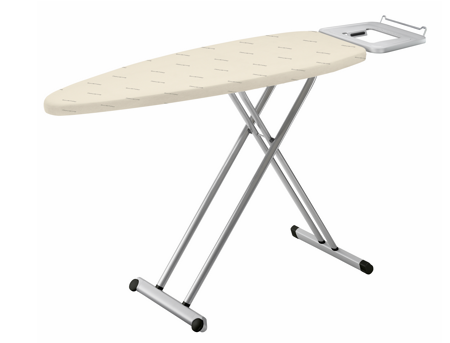Ironing Board
An ironing board is a foldable and portable table that has a heat-resistant surface. Overall, it comprises two primary parts, which are the flatbed and collapsible legs. The flatbed provides a surface on which garments are ironed while the collapsible legs are hinged so that the iron board can be easily folded for storage. The flatbed is covered by fabric or clothing that is securely draped across a board using clips or tied to a string on the board.
It is also essential to note that an iron board can exist as either a stand-alone item or wall-mounted onto a cabinet. As a result, there are three types of ironing boards; freestanding, compact, and built-in ironing boards (Mifflin, 2019). The freestanding ironing board is made of metal and has an adjustable height mechanism.
This ironing board is most suitable when using a steam-generating iron since the high-pressure steam is capable of penetrating the pad via the metal mesh surface. Second is the compact ironing board that is smaller than the freestanding version and has no height adjustments. Last is the built-in ironing board that is mounted on a wall cabinet, hence can be stored out of sight.

Although iron boards can exist as either a stand-alone item or wall-mounted onto a cabinet, their function and design are still the same. Modern ironing boards are usually made of metal but are available in several designs. However, a standard, inexpensive ironing board is made up of the following parts:
- Cover – It is the uppermost layer of material that comes into contact with the iron and the clothing. For safety reasons, it is usually heat resistant or heatproof. The cover comes in various patterns and colors.
- Padding – It lies underneath the cover. It is made of synthetic or cotton fibers, or a thin layer of foam. Its function is to give the body to the surface of the ironing board.
- Face – It is the horizontal structural element of the ironing board top that holds the cover and the padding. It is usually made of metal and is broad and tapered at either end. Small sections of clothing, such as the shirt sleeves and pant legs are ironed at the tapered end, while the other large sections of garments are ironed at the broad end. Moreover, the face has many holes on the surface to help aerate the iron board; hence keeping it cool while ironing.
- Legs and mechanical latches – The legs of the ironing board are made of hollow light metal that intersect to give the ironing board stability. Moreover, they are padded at the feet so that they cannot mar the floors. The legs are capable of moving; therefore, this allows for the folding and unfolding of the iron board. The before-mentioned movement is controlled by a small lever that controls the latch, which in turn controls the movement of the legs; in other words, the collapsible nature of the iron boards.
- Extras – Different iron boards have varying extra features. This is dependent on the price and functionality of the iron board. For instance, some comprise of a special dock for holding the iron box and a vertical pole for safely holding the cord away. However, others constitute a clothing bar on which garments are hanged after they are pressed.
- Variations – Depending on the use and customers’ needs, there are small ironing boards that are constructed for traveling and small rooms. These have fewer parts and can be folded up to fit into a shallow cabinet.
Conclusion
The use of an ironing board and the iron box is still the popular method of keeping clothes wrinkle-free. The ironing board serves the purpose of providing a surface on which clothing is pressed. It is made up of parts of appropriate material and design to ensure that it serves its function. One major adaptation is the fact that the pad is made up of heat-resistant material. Furthermore, there are different designs of iron boards that have been constructed to suit the consumers’ needs.
Reference
Mifflin, M. (2019). An overview of ironing boards. Web.